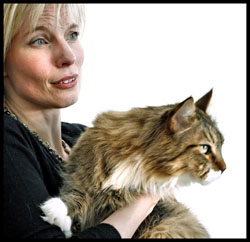
Dr. Danielle Gunn-Moore

Photo by Paul Dodds
Dr. Danielle Gunn-Moore, pictured with her cat, Mortlach, is personal chair of feline medicine at the University of Edinburgh.
Veterinarians in the United Kingdom are being warned about a new and unusual outbreak of feline tuberculosis that has struck at five separate locations in England.
Pet cats at the as-yet-undisclosed sites caught a strain of TB caused by Mycobacterium bovis, a bacterium more typically found in cattle and wild animals such as bison, deer and elk. According to TBfacts.org, the pathogen can affect practically all mammals, including humans; however, by far the more common cause of TB in people is Mycobacterium tuberculosis. M. bovis has been associated with TB in cats in the past, including in England and the United States.
The latest cases in the U.K. involve young cats with no history of outdoor access, which is noteworthy because M. bovis usually infects cats via bites and scratches while they are hunting outside.
Investigators suspect the source of the cats' exposure was their diet: All of the affected pets were fed the same brand of commercial raw, frozen food. The brand's name has not been made public.
The VIN News Service asked Dr. Danielle Gunn-Moore, an expert in feline TB at the University of Edinburgh who is investigating the outbreak, what veterinarians and the public should know.
What are the symptoms of the bovine strain of TB, and is it usually fatal?
TB caused by M. bovis in cats in the U.K. is usually cutaneous and caused by bite wounds and wound contamination from infected rodents. It usually presents as lesions around the wound, being seen as non-healing wounds or ulcers.
These new cases, however, are intestinal. Sufferers therefore typically present with weight loss, abdominal masses, and diarrhea. Without treatment, the disease is fatal.
What other clues should veterinarians consider when making a diagnosis?
Of note, almost all of the recent cases have been seen in young, often pedigreed, cats that are not allowed outside and hence, do not hunt.
We would like to urge clinicians to be aware of the possibility of tuberculosis in such cats, particularly if they have been fed on a raw-food diet.
Could clinical signs of M. bovis infection resemble anything else?
The two diseases vets are most likely to think the cats have are feline infectious peritonitis, known as FIP, or intestinal lymphoma — a type of cancer.
Both are seen most commonly in young, pedigreed cats.
Is there a test to diagnose the disease?
Yes, the blood test is the Interferon gamma release assay, or IGRA.
Otherwise, a needle aspirate or biopsy needs to be taken and sent for cytology or histopathology — to look for typical changes — then specialist culture or PCR (polymerase chain reaction).
Can the disease be treated, or are infected animals euthanized?
If the cats are diagnosed early, treatment could be considered — but the infection is a risk to the owners, and the treatment of the cat would involve three drugs being given daily for at least six months.
What risk do infected cats pose to human health?
There have only been six cases of M. bovis being passed from cats to people reported globally over the last 150 years.
Is the latest outbreak confined to five sites and is pet food definitely the cause?
Other households are being investigated and we are still investigating the possible link to commercial raw food. The food samples were taken at the time of diagnosis, not the time of infection, so may only offer circumstantial evidence.
Three of the five households were in low-risk bovine TB zones, another was in an "edge" area and only one was in a high-risk location. It's unusual for such a rare form of gastrointestinal feline TB to occur in indoor cats at multiple locations, particularly low-risk ones.
From your own research, how many cats could be infected with feline TB?
Cats are most commonly infected with either M. bovis or M. microti, which also can be picked [up] from rodents, and also cause skin lesions near wounds.
Of biopsies for cats from all over U.K., taken for any reason and sent to labs for histopathology, 1 percent are found to have changes typical of mycobacterial infection. So infection of cats with mycobacteria are not rare. Of those, around a third of cases are caused by bacteria that cause TB, i.e. M. bovis or M. microti.
Veterinarians in the U.K. who suspect they may have encountered a case of gastrointestinal feline TB may contact Gunn-Moore at: Danielle.Gunn-Moore@ed.ac.uk